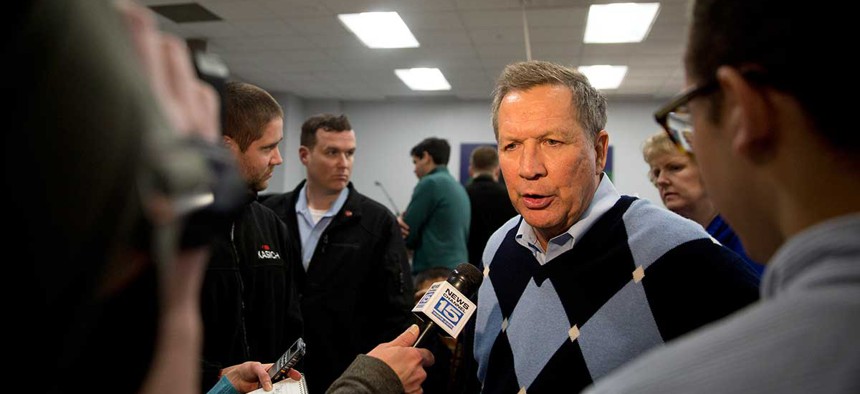
John Kasich speaks to reporters after a town hall meeting in Davenport, Iowa. Mary Altaffer/AP
The Frustrations of Divided Government Play Out in Iowa Races
Voters don’t agree on the country’s biggest problems, never mind the solutions.
AMES, Iowa—It doesn’t take much time with voters in Iowa to recognize that the 2016 presidential race is being fought in the chasm between the towering challenges facing the country and the crimped responses that our polarized and paralyzed political system can now produce.
Republican and Democratic audiences here diverge wildly in their preferred solutions for the country’s biggest problems—and even over what issues qualify for that list. But they are united by a common conviction that Washington is now incapable of moving very far in any direction. As next week’s Iowa caucuses formally begin the 2016 voting, each party is dividing over how to break that impasse—with evolutionary change that works within today’s limits or with the promise of a revolution that somehow washes those limits away?
On both sides, the energy is with candidates (Bernie Sanders for the Democrats, and Donald Trump and Ted Cruz for the Republicans) offering the dream of a clean sweep and a blank sheet on which to rewrite the nation’s priorities. Yet because the candidates offering such fundamental change are largely misdiagnosing the reasons for today’s impasse, it’s unlikely they could break it even if they capture the presidency. Given the nation’s underlying partisan divisions, the only way to advance bigger ideas may be through compromises across party lines that neither side is discussing much yet.
In both parties, this election is almost physically vibrating with the accumulated frustration of political life under a divided government. By Election Day, one party will have simultaneously controlled the White House, Senate, and House of Representatives for just 12 of the 48 years since 1968. By contrast, one party held unified control of all three branches for fully 58 of the 72 years before then.
During his first two years, President Obama achieved big legislative breakthroughs with unified control (and the biggest, if fleeting, Democratic Senate majority since Jimmy Carter). But after Republicans regained the House (in 2010) and the Senate (in 2014) it’s been trench warfare in which Obama has increasingly turned to unilateral executive action (on issues like climate and immigration) to further his goals. That’s left liberals frustrated that Obama couldn’t achieve more—and conservatives steamed that the Republican Congress couldn’t undo more of what he did achieve.
The 2016 candidates are diverging over how they would break this stalemate. Democratic Sen. Bernie Sanders has built his campaign on promising to mobilize a transformative movement against the “billionaire class.” When he appeared at Iowa State University here Monday, his first words were, “So, you guys ready to make a political revolution?” In Sanders’s vision, a massive grassroots uprising will shatter the constricting limits of today’s political debate and thrust forward long-time liberal goals such as single-payer health care and free public-college tuition.
For Sanders’s growing army, it’s an exhilarating prospect. But even some who cheer his goals question how he will overcome opposition from Republicans irrevocably opposed to them. “My only question is does he have the ability to carry some of these radical ideas through?” said Mark Bergstrom, an engineer from Minneapolis, who drove down to hear Sanders.
Hillary Clinton increasingly is presenting herself as the pragmatic doer to Sanders’s poetic dreamer. Her core case is that she can push more progressive gains through the current clogged system—even if her goals aren’t as sweeping as Sanders’s. Bergstrom is like many Democrats who find Sanders’s argument more inspiring and Clinton’s more realistic. Still undecided, he says that along with his wife he’s weighing, “Do we vote for smaller changes in a direction we believe in [with Clinton], or make a bigger gamble [with Sanders]?”
How other Democrats answer that question will determine whether Sanders can truly threaten the front-runner.
Among Republicans, the candidates largely promising to work within the system (Jeb Bush, John Kasich, Chris Christie, and, up to a point, Marco Rubio) are all struggling. Those promising to raze the system lead the field: Cruz, and above all, Trump.
While Sanders promises bottom-up change powered by a grassroots movement, Trump offers the opposite: top-down change catalyzed by his forceful personality and deal-making acumen. Trump seems genuinely convinced he could negotiate with Congressional Democrats if elected. “That’s the way the country is supposed to work,” he insisted in Marshalltown this week.
But Trump’s key goals, such as building a border wall or massively deporting undocumented immigrants, offer little basis for bipartisan agreement. And apart from touting his own skill at “the art of the deal,” he offers no plausible path through the many legal and political barriers any such efforts would face, such as the need for big funding increases from Congress.
In fact, from Sanders to Trump, all of 2016’s revolutionaries inaccurately blame today’s impasse on weak leaders or strong special interests. Instead, it persists mostly because the country is now divided almost evenly between two political coalitions with antithetical visions of America’s future. Neither is going away after the next election. To achieve big change in 2017, the party that wins the White House still will almost certainly need to forge reasonable compromises with the losing side—even if that’s not a message that’s warming many partisan hearts in the blustery Iowa chill before next week’s fiercely contested vote.







